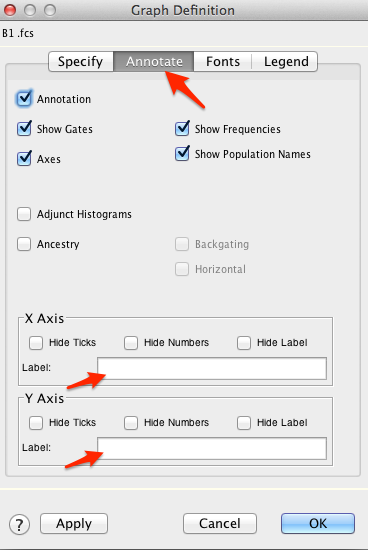

# Create a legend in the top-left corner that is slightly # smaller and has no border Lines(autos_data$suvs, type=" l", lty=3, lwd=2, # Graph suvs with thicker green dotted line Lines(autos_data$trucks, type=" l", lty=2, lwd=2, # Graph trucks with thicker red dashed line Xpd=T, cex=0.8) # Plot y axis with smaller horizontal labels

# Plot x axis labels at default tick marks with labels at # 45 degree angle text(axTicks(1), par("usr") - 2, srt=45, adj=1,

Ylim= range(autos_data), axes=F, ann=T, xlab="Days", ylab="Total", cex.lab=0.8, lwd=2) Plot(autos_data$cars, type= "l", col=plot_colors, Label axes with smaller font and use larger # line widths.
Flowjo 10 histogram percentage of max pdf#
# Start PDF device driver to save output to figure.pdf pdf(file="C:/R/figure.pdf", height=3.5, width=5) # Trim off excess margin space (bottom, left, top, right) par(mar=c(4.2, 3.8, 0.2, 0.2)) # Graph autos using a y axis that uses the full range of value # in autos_data. # Define colors to be used for cars, trucks, suvs # Read car and truck values from tab-delimited autos.datĪutos_data <- read.table("C:/R/autos.dat", header=T, sep="\t") # Turn off device driver (to flush output to png) dev.off() Legend(1, max_y, names(autos_data), cex=0.8, col= plot_colors, # Create a legend at (1, max_y) that is slightly smaller # (cex) and uses the same line colors and points used by # the actual plots # Label the x and y axes with dark green text # Graph suvs with green dotted line and diamond points lines(autos_data$suvs, type="o", pch=23, lty=3,Ĭol=plot_colors) # Create a title with a red, bold/italic font Lines( autos_data$trucks, type="o", pch=22, lty=2, # Graph trucks with red dashed line and square points # Make y axis with horizontal labels that display ticks at # every 4 marks. # Turn off axes and annotations (axis labels) so we can # specify them ourself # Read car and truck values from tab-delimited autos.dat autos_data <- read.table("C:/R/autos.dat", header=T, sep="\t") # Compute the largest y value used in the data (or we could # just use range again) max_y <- max(autos_data) # Define colors to be used for cars, trucks, suvs plot_colors <- c("blue","red","forestgreen") # Start PNG device driver to save output to figure.png png(filename="C:/R/figure.png", height=295, width=300,īg="white") # Graph autos using y axis that ranges from 0 to max_y. Title(ylab="Total", col.lab=rgb(0,0.5,0)) # Create a legend at (1, g_range) that is slightly smaller # (cex) and uses the same line colors and points used by # the actual plots legend(1, g_range, c("cars","trucks"), cex=0.8,Ĭol=c("blue","red"), pch=21:22, lty=1:2) # Label the x and y axes with dark green text title(xlab="Days", col.lab=rgb(0,0.5,0)) Title(main="Autos", col.main="red", font.main=4) # Create a title with a red, bold/italic font axis(2, las=1, at=4*0:g_range) # Create box around plot box() # Graph trucks with red dashed line and square points # Make x axis using Mon-Fri labels axis(1, at=1:5, lab=c("Mon","Tue","Wed","Thu","Fri")) # Make y axis with horizontal labels that display ticks at # every 4 marks. Plot(cars, type="o", col="blue", ylim= g_range, Turn off axes and # annotations (axis labels) so we can specify them ourself # Calculate range from 0 to max value of cars and trucks g_range <- range(0, cars, trucks) # Graph autos using y axis that ranges from 0 to max # value in cars or trucks vector.


 0 kommentar(er)
0 kommentar(er)
